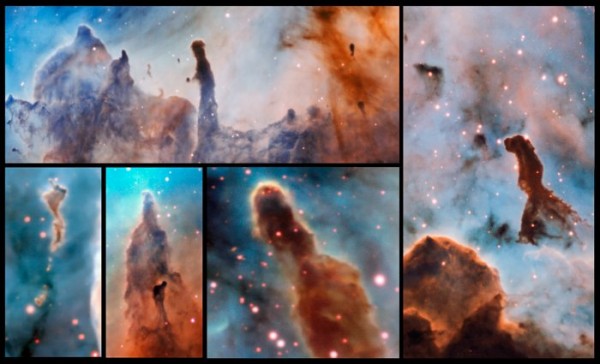By Ana Verayo, | November 03, 2016

The massive stars within the star formation region slowly destroy the pillars of dust and gas from which they are born. (ESO/A. McLeod)
New images have revealed the incredible "Pillars of Destruction" courtesy of the European Southern Observatory, showing colossal gas and dust pillars spanning light years across, inside the Carina Nebula. Scientists are now studying these cosmic pillars to gain a better understanding of how stars are born and destroyed.
Like Us on Facebook
Mission scientists used the ESO's Very Large Telescope and its Muse instrument to peer through inside this violent nebula some 7,500 light years away. These images were taken and processed in different light wavelengths for scientists to identify the chemical properties and dynamic processes inside these pillars.
ESO scientists say that the Carina Nebular Complex is considered to be the most massive star-forming region inside the Milky Way galaxy as they assessed other nebular regions including the iconic Pillars of Creation inside the Eagle Nebula and those in NGC 3603 which is a gigantic nebula located 20,000 light years away.
Inside these pillars, scientists discovered intense radiation emitted by neighboring stars in the pillars as these massive stars suck out stellar mass from them in a cosmic process known as "photoevaporation."
More specifically, the stars inside these pillars emit blasts of ionized radiation that strip away atoms from electrons, resulting in stellar mass loss inside the pillars. Scientists say that they found links between electron density and an ionizing photon flux that resulted in this mass loss rate.
This new study about how stars are born inside the Carina Nebula was published in the journal Monthly Notices of the Royal Astronomical Society.
-
Use of Coronavirus Pandemic Drones Raises Privacy Concerns: Drones Spread Fear, Local Officials Say

-
Coronavirus Hampers The Delivery Of Lockheed Martin F-35 Stealth Fighters For 2020

-
Instagram Speeds Up Plans to Add Account Memorialization Feature Due to COVID-19 Deaths

-
NASA: Perseverance Plans to Bring 'Mars Rock' to Earth in 2031

-
600 Dead And 3,000 In The Hospital as Iranians Believed Drinking High-Concentrations of Alcohol Can Cure The Coronavirus

-
600 Dead And 3,000 In The Hospital as Iranians Believed Drinking High-Concentrations of Alcohol Can Cure The Coronavirus

-
COVID-19: Doctors, Nurses Use Virtual Reality to Learn New Skills in Treating Coronavirus Patients







